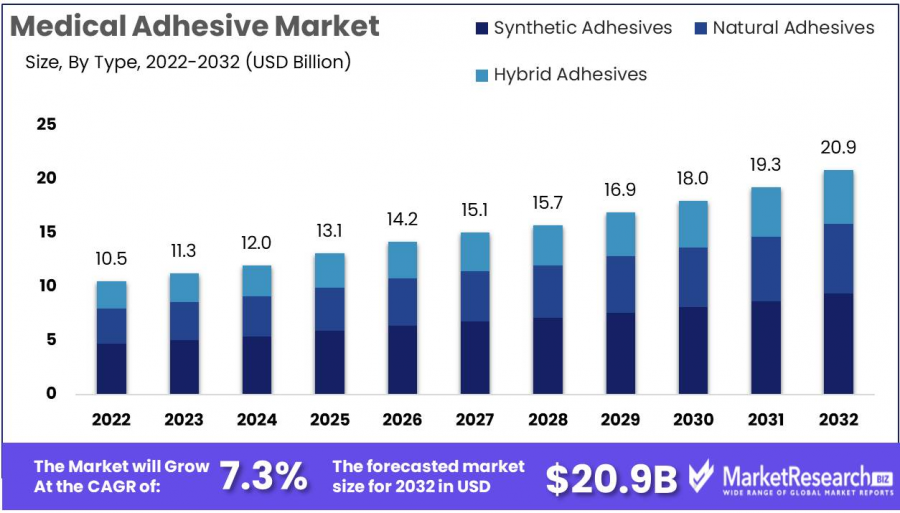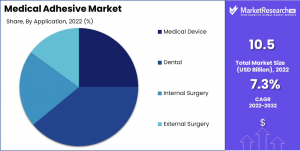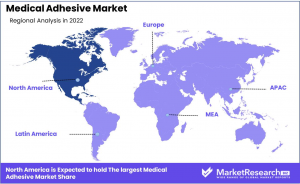
Medical Adhesive Market Set for Strong Growth, Projected to Reach USD 20.9 Billion by 2032
Global Medical Adhesive Market size is expected to be worth around USD 20.9 Bn by 2032 from USD 11.3 Bn in 2023, growing at a CAGR of 7.3%
NEW YORK, NY, UNITED STATES, February 14, 2025 /EINPresswire.com/ -- Overview
Global Medical Adhesive Market size is expected to be worth around USD 20.9 Bn by 2032 from USD 11.3 Bn in 2023, growing at a CAGR of 7.3% during the forecast period from 2023 to 2032.
Medical adhesives play a vital role in healthcare, offering secure wound closure, surgical bonding, and medical device fixation. These advanced adhesives enhance patient safety, reduce infection risks, and accelerate healing, making them indispensable in hospitals, clinics, and home care settings.
Medical adhesives come in various forms, including tapes, films, and liquid adhesives, each serving a critical function. Cyanoacrylates, fibrin-based adhesives, and hydrocolloid adhesives are widely used in surgeries, wound care, and wearable medical devices. Their ability to replace traditional sutures and staples improves patient comfort and minimizes scarring.
The global demand for medical adhesives is rising, driven by minimally invasive surgeries, the increasing prevalence of chronic wounds, and advancements in biocompatible materials. Regulatory bodies like the FDA and EMA ensure these adhesives meet strict safety and performance standards.
Technological innovations are introducing bio-based and antimicrobial adhesives, improving adhesion strength and reducing allergic reactions. As the healthcare industry moves toward enhanced patient care and infection control, medical adhesives continue to play a crucial role in surgical and wound management solutions.
Click here to get a Sample report copy @ https://marketresearch.biz/report/medical-adhesive-market/request-sample/
Key Takeaways
•Market Growth: The medical adhesive market is expanding due to increasing demand in wound care, surgical procedures, and medical device fixation.
•Rising Demand: Growth is driven by minimally invasive surgeries, chronic wound treatments, and wearable medical devices.
•Material Advancements: Innovations in bio-based, antimicrobial, and biocompatible adhesives improve safety and performance.
•Regulatory Compliance: Strict regulations by FDA, EMA, and ISO standards ensure product safety and efficacy.
•End-User Dominance: Hospitals and ambulatory surgical centers are the largest consumers due to high surgical volumes.
•Regional Insights: North America dominates the market, followed by Europe and Asia-Pacific due to rising healthcare investments.
•Technology Trends: Smart adhesives with drug delivery and enhanced bonding strength are emerging innovations.
•Competitive Landscape: Key players focus on product innovation and biocompatibility enhancements to meet growing healthcare needs.
•Challenges: High production costs and stringent regulatory requirements may hinder market expansion.
•Future Outlook: Increasing adoption of skin-friendly and antimicrobial adhesives will drive continued growth.
Segmentation Analysis
••Type Analysis: The Synthetic Adhesives segment leads the medical adhesive market, offering strong bonding, flexibility, and chemical resistance. These adhesives are widely used in surgical procedures, wound care, and medical device fixation. Consumer preference for safe, hypoallergenic materials has driven demand, as synthetic adhesives reduce skin irritation and ensure patient comfort. Their durability and reliability make them the preferred choice in healthcare settings, contributing to their dominance in the market.
••Technology Analysis: The Solid & Hot Melts segment holds a significant share in the medical adhesive market due to its high bond strength and heat resistance. These adhesives are widely used in wound care, device assembly, and surgical applications. Healthcare providers prefer strong, reliable adhesives that can withstand environmental factors. The growing demand for high-performance adhesives in complex medical procedures has fueled the adoption of solid and hot melt adhesives, ensuring durability and long-term adhesion.
••Application Analysis: The Dental Segment dominates the medical adhesive market, playing a vital role in dental restorations and prosthetics. Dental adhesives provide strong, long-lasting bonds for minimally invasive treatments. Patients prefer conservative dentistry, opting for adhesives that preserve natural tooth structure. With increasing demand for durable and precise dental solutions, dental adhesives have become essential in clinics and laboratories, contributing to their market leadership.
Market Segments
By Type
•Synthetic Adhesives
•Natural Adhesives
•Hybrid Adhesives
By Technology
•Water Based
•Solid & Hot Melts
•Solvent Based
•Other Technologies
By Application
•Medical Device
•Dental
•Internal Surgery
•External Surgery
To Purchase this Premium Report @ https://marketresearch.biz/purchase-report/?report_id=8564
How Artificial Intelligence (AI) is Changing the Medical Adhesive Market?
Accelerated Research and Development: AI enables rapid analysis of complex data, allowing researchers to predict how different adhesive formulations will perform. By utilizing machine learning algorithms, developers can simulate various combinations of materials to identify optimal adhesive properties, significantly reducing the time and cost associated with traditional experimental methods.
Enhanced Material Properties: Incorporating AI in the design of medical adhesives leads to the discovery of novel materials with improved characteristics. For instance, AI has been used to design derivatives of 3,4-dihydroxyphenyl-L-alanine (L-DOPA), inspired by the adhesive properties of marine mussels, resulting in biofriendly adhesives with strong adhesion suitable for medical applications.
Optimized Manufacturing Processes: AI assists in refining manufacturing workflows by predicting potential issues and suggesting process improvements. By analyzing data from production lines, AI systems can identify inefficiencies and recommend adjustments, leading to higher quality products and reduced waste.
Market Dynamics
•Driver: The increasing prevalence of chronic diseases and the rising number of surgical procedures have led to a higher demand for medical adhesives. These adhesives are essential in wound care and surgical settings, providing secure closure and promoting healing. The aging global population further contributes to this demand, as older individuals often require more medical interventions. According to the World Health Organization (WHO), the global population aged 60 years and over is expected to double by 2050, reaching 2.1 billion, thereby increasing the need for medical adhesives in various treatments.
•Trend: There is a growing trend towards the development and adoption of bioresorbable and biocompatible medical adhesives. These advanced adhesives are designed to be absorbed by the body over time, reducing the need for removal and minimizing adverse reactions. This trend aligns with the broader movement towards minimally invasive procedures and the use of materials that support natural healing processes. The U.S. Food and Drug Administration (FDA) has been actively involved in evaluating and approving such innovative medical devices, reflecting the industry's shift towards safer and more effective adhesive solutions.
•Restraint: Stringent regulatory requirements and the need for extensive clinical testing pose significant challenges to the development and commercialization of new medical adhesives. Ensuring product safety and efficacy necessitates compliance with rigorous standards set by regulatory bodies such as the FDA and the European Medicines Agency (EMA). This process can be time-consuming and costly, potentially hindering innovation and delaying the availability of new products to the market. Additionally, concerns about potential allergic reactions and biocompatibility issues may limit the adoption of certain adhesive formulations.
•Opportunity: The increasing focus on personalized medicine and tailored healthcare solutions presents a significant opportunity for the medical adhesive market. Developing adhesives that can be customized to individual patient needs, such as those with specific allergies or sensitivities, can enhance patient outcomes and satisfaction. Furthermore, the integration of antimicrobial properties into medical adhesives offers the potential to reduce infection rates in surgical and wound care applications. Research funded by the National Institutes of Health (NIH) is exploring innovative approaches to incorporate such properties, aiming to improve the safety and effectiveness of medical adhesives in clinical settings.
Market Key Players
•Ethicon US LLC.
•Medtronic
•B. Braun Melsungen AG
•Henkel AG & Co. KGaA
•BD
•Glaxosmithkline PLC
•Cohera Medical Inc.
•Ashland
•John Wiley & Sons Inc.
•Ocular Therapeutix Inc.
•Procter & Gamble Co.
•Chemence
•Baxter
•Vivostat A/S
•Gem srl
•Dentsply Sirona
•GluStitch
•H.B. Fuller Company.
•CryoLife Inc
•DuPont and 3M
Regional Analysis
North America stands as the dominant force in the medical adhesive market, driven by technological advancements, a strong healthcare sector, and ongoing innovation. Several key factors contribute to the region’s market leadership and competitive edge.
A major driver is North America’s commitment to research and development (R&D). Leading manufacturers invest heavily in developing advanced medical adhesives, ensuring safety, reliability, and compliance with strict regulatory standards. These continuous innovations keep the region at the forefront of global medical adhesive solutions.
Collaboration between industry and academia further strengthens North America’s position. Top universities and research institutions work closely with medical adhesive manufacturers, fostering breakthrough developments and cutting-edge applications. These partnerships accelerate the introduction of high-performance adhesive solutions tailored to evolving healthcare needs.
Technological progress has also been instrumental in the growth of the North American medical adhesive market. The region consistently invests in advanced manufacturing processes that ensure high-quality production. Additionally, North America’s well-developed healthcare infrastructure, comprising world-class hospitals and treatment centers, demands superior medical adhesives for surgical, wound care, and device applications. This strong demand further cements North America’s leadership in the global market.
Emerging Trends in Medical Adhesives
•Bio-Inspired Adhesives: Researchers are developing adhesives inspired by natural substances, such as those mimicking the adhesive properties of mussels. These bio-inspired adhesives aim to provide strong bonding while being biocompatible and environmentally friendly.
•Smart Adhesives: The advent of "intelligent" materials has led to the development of smart bioadhesives that respond to various stimuli, such as light, temperature, pH, and electric fields. These adhesives can adapt their properties in response to environmental changes, enhancing their effectiveness in dynamic biological environments.
•Protein-Based Adhesives: Advancements in protein-based adhesives have shown promise in medical applications. These adhesives utilize natural proteins to create strong bonds with tissues, offering potential benefits in terms of biocompatibility and reduced immune response.
Use Cases of Medical Adhesives
•Surgical Wound Closure: Medical adhesives are increasingly used as alternatives to sutures and staples for closing surgical wounds. They offer benefits such as reduced scarring, decreased operation time, and lower infection rates. For example, tissue adhesives have been applied in various surgical procedures to re-approximate wounded tissues effectively.
•Ophthalmic Surgeries: In ophthalmology, tissue adhesives are gaining popularity for procedures like corneal grafts and sealing incisions. They potentially reduce complications associated with traditional surgical methods and improve patient outcomes.
•Dental Applications: In dentistry, adhesives are used for bonding brackets in orthodontics, attaching prosthetics, and sealing cavities. They provide strong bonds in the moist environment of the mouth and can be removed without residue when necessary.
Lawrence John
Prudour
+91 91308 55334
Lawrence@prudour.com
Distribution channels: Healthcare & Pharmaceuticals Industry
Legal Disclaimer:
EIN Presswire provides this news content "as is" without warranty of any kind. We do not accept any responsibility or liability for the accuracy, content, images, videos, licenses, completeness, legality, or reliability of the information contained in this article. If you have any complaints or copyright issues related to this article, kindly contact the author above.
Submit your press release


